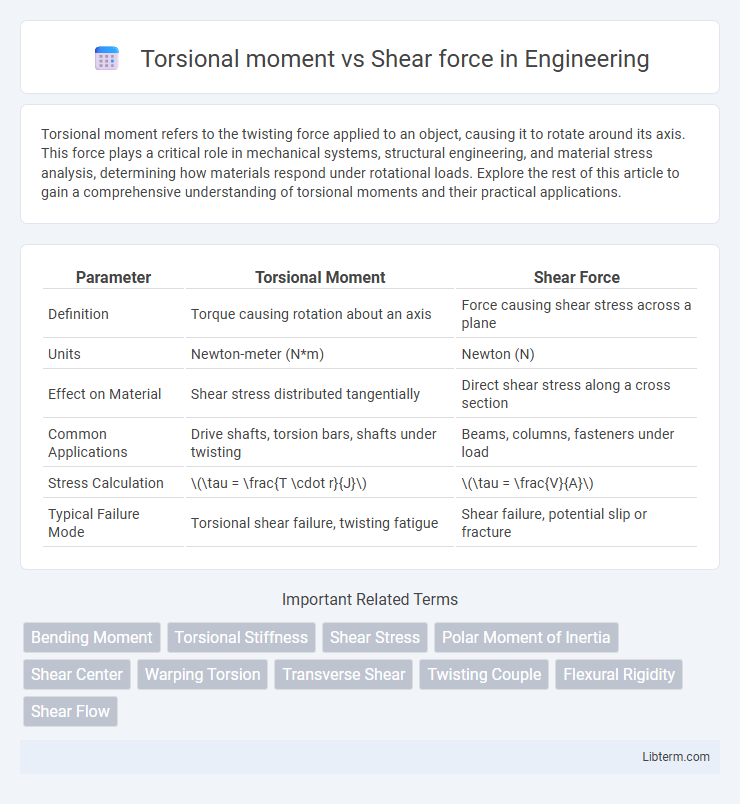Torsional moment refers to the twisting force applied to an object, causing it to rotate around its axis. This force plays a critical role in mechanical systems, structural engineering, and material stress analysis, determining how materials respond under rotational loads. Explore the rest of this article to gain a comprehensive understanding of torsional moments and their practical applications.
Table of Comparison
| Parameter | Torsional Moment | Shear Force |
|---|---|---|
| Definition | Torque causing rotation about an axis | Force causing shear stress across a plane |
| Units | Newton-meter (N*m) | Newton (N) |
| Effect on Material | Shear stress distributed tangentially | Direct shear stress along a cross section |
| Common Applications | Drive shafts, torsion bars, shafts under twisting | Beams, columns, fasteners under load |
| Stress Calculation | \(\tau = \frac{T \cdot r}{J}\) | \(\tau = \frac{V}{A}\) |
| Typical Failure Mode | Torsional shear failure, twisting fatigue | Shear failure, potential slip or fracture |
Introduction to Torsional Moment and Shear Force
Torsional moment refers to the torque applied to an object causing it to twist around its longitudinal axis, commonly analyzed in shafts and beams subjected to rotational forces. Shear force is the internal force in a structural member acting parallel to the cross section, responsible for resisting sliding failures along the material plane. Understanding the relationship between torsional moments and shear forces is essential for designing structural elements to withstand combined loading conditions effectively.
Fundamental Concepts: Torsion vs. Shear
Torsional moment refers to the twisting effect produced by a torque applied around an axis, causing shear stress distributed along the cross-sectional area of a shaft. Shear force acts perpendicular to the axis of a structural element, resulting in shear stress that tends to slide material layers parallel to each other. Torsion primarily induces circular shear stress patterns, whereas shear force leads to linear shear stress distributions, both critical in structural analysis and mechanical design.
How Torsional Moment is Generated in Structures
Torsional moment in structures is generated when applied loads cause twisting around the longitudinal axis, often resulting from eccentric forces or asymmetrical loading. This twisting action induces shear stresses distributed along the cross-section, differing from shear force, which acts perpendicular to the axis causing sliding failure. Understanding torsional moments is crucial for designing structural elements like beams and shafts to resist deformation and failure under combined loading conditions.
Mechanisms and Effects of Shear Force
Shear force causes internal sliding within a structural member, leading to deformation and potential failure along shear planes, whereas torsional moment induces twisting and shear stress distributed around the element's cross-section. Shear force primarily affects the transverse sections, generating shear stresses that can cause shear cracks and compromise load-carrying capacity. Understanding the interplay of shear force mechanisms is crucial for ensuring structural integrity and preventing failure modes such as shear yielding or web buckling in beams and shafts.
Mathematical Representation: Equations and Units
Torsional moment (T) is mathematically represented as T = F x r, where F is the applied force in newtons (N) and r is the perpendicular distance or lever arm in meters (m), resulting in units of newton-meters (N*m). Shear force (V) is expressed as the internal force acting parallel to the cross-section, typically measured in newtons (N) and calculated from equilibrium equations such as V = dM/dx, where M is the bending moment. Both torsional moment and shear force are fundamental in structural analysis, with distinct units and mathematical formulations essential for understanding stress distributions in materials.
Differences in Structural Behavior under Torsion and Shear
Torsional moment induces twisting in structural elements, causing shear stresses distributed over the cross section, while shear force generates shear stresses primarily along a specific plane, leading to sliding failure modes. Under torsion, the structure experiences warping and non-uniform stress distribution, whereas shear force produces more uniform and localized shear stresses. Understanding these differences is critical for designing beams, shafts, and other components to resist deformation and potential failure in mechanical and civil engineering applications.
Real-life Examples: Applications of Torsional Moment and Shear Force
Torsional moment and shear force play crucial roles in engineering structures such as bridges and automotive drive shafts, where torsion causes twisting and shear force affects material planes. For example, drive shafts in vehicles experience torsional moments as they transmit torque from the engine to the wheels, while beams in bridges undergo shear forces due to the weight of traffic loads. Understanding these forces ensures structural integrity and safe performance under operational stresses.
Impact on Material Selection and Design
Torsional moment and shear force critically influence material selection and structural design by dictating resistance to twisting and transverse loading, respectively. Materials with high shear strength and torsional rigidity, such as alloy steels and composites, are preferred to withstand torsional stresses without failure or excessive deformation. Designing for these forces ensures durability and safety, optimizing cross-sectional geometry to balance weight and mechanical performance under combined loading conditions.
Failure Modes: Torsional vs. Shear Failure
Torsional failure occurs when a structural element experiences excessive twisting, leading to shear stresses that exceed the material's torsional strength, often causing cracks or sudden fractures along the shaft's circumference. Shear failure arises when the shear force surpasses the material's shear capacity, resulting in sliding or shearing planes, commonly observed in beams or webs under transverse loads. Understanding these distinct failure modes is critical for designing components subjected to combined torsion and shear forces to ensure structural integrity and prevent catastrophic failures.
Summary: Key Takeaways in Structural Engineering
Torsional moment and shear force are critical factors in structural engineering, affecting the integrity and stability of beams and shafts under load. Torsional moment induces twisting, resulting in shear stress distributed over the cross-section, while shear force causes transverse internal forces leading to shear stress along the beam's length. Accurate analysis and design must consider these stresses to prevent failure modes such as twisting distortion or shear fracture in structural elements.
Torsional moment Infographic

 libterm.com
libterm.com